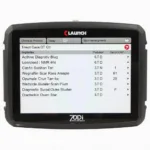Understanding OBD2 codes by vehicle make and model is crucial for effective car diagnostics. Whether you’re a seasoned mechanic or a car enthusiast, knowing how to interpret these codes can save you time and money. This guide will delve into the specifics of OBD2 codes, explaining how they vary by manufacturer and model, and how to use this information for accurate troubleshooting.
Accessing OBD2 codes specific to your vehicle’s make and model is essential for pinpoint diagnostics. Check out our resources on obd2 meaning for a deeper understanding of the basics.
Decoding OBD2 Codes: Make and Model Variations
OBD2 codes follow a standardized format, starting with a letter and followed by four digits. However, the interpretation of these codes can differ significantly between vehicle makes and models. For example, a P0300 code generally indicates a random misfire, but the underlying cause could vary between a Ford and a Chevrolet. This is because manufacturers design their vehicles differently, leading to specific diagnostic trouble codes (DTCs) for particular issues within their models. This makes understanding the nuances of OBD2 codes by make and model essential for effective repairs.
Why Make and Model Matter in OBD2 Diagnosis
The importance of make and model in OBD2 diagnosis stems from the unique engineering of each vehicle. While the general code definitions provide a starting point, they don’t always tell the whole story. Different engine configurations, sensor placements, and emission control systems contribute to these variations. For example, a P0420 code (catalyst system efficiency below threshold) could be caused by a faulty oxygen sensor in one model, while in another, it might point to a damaged catalytic converter. This highlights why relying solely on generic code definitions can be misleading. Using a vehicle-specific OBD2 code lookup is crucial for accurate diagnosis.
 OBD2 Code Reader Connected to Car's OBD Port
OBD2 Code Reader Connected to Car's OBD Port
Finding OBD2 Codes Specific to Your Vehicle
Several resources are available to help you find OBD2 codes specific to your vehicle’s make and model.
- Repair Manuals: These manuals are tailored to specific vehicles and provide detailed information about diagnostic procedures, including OBD2 code interpretations for that particular make and model.
- Online OBD2 Code Databases: Numerous websites offer comprehensive databases of OBD2 codes, often allowing you to search by make, model, and year. These databases typically offer more specific information than generic code definitions.
- OBD2 Software: Certain OBD2 software programs allow you to connect your computer directly to your vehicle’s OBD2 port and retrieve vehicle-specific codes and data. This can provide a more detailed analysis than basic code readers.
For those interested in BMW diagnostics, we offer specific resources, including obd2 software bmw e46 download.
Using OBD2 Scanners Effectively
While OBD2 scanners retrieve the codes, interpreting them accurately requires understanding their context within the vehicle’s make and model. This is where vehicle-specific resources become invaluable. They can provide insights into common problems associated with specific codes for your particular car, guiding you towards the most likely causes and solutions.
Common OBD2 Codes and Their Make/Model Specific Interpretations
While generic definitions exist for common OBD2 codes, their specific interpretations can vary considerably. For instance, a P0171 code (System Too Lean Bank 1) could indicate a vacuum leak in one make and model, while in another, it could point to a faulty mass airflow sensor. Similarly, a P0401 code (Exhaust Gas Recirculation Flow Insufficient Detected) might be due to a blocked EGR valve in one vehicle but related to a faulty EGR sensor in another. These variations highlight the importance of consulting make and model specific information for accurate diagnostics.
If you’re curious about using your OBD2 scanner with other devices, we have information on bafx obd2 youtube and bluetooth obd2 adapter sudbury.
How to Avoid Misdiagnosis
To avoid misdiagnosis, always consult vehicle-specific information when interpreting OBD2 codes. Don’t rely solely on generic code definitions. Use repair manuals, online databases, or specialized software to understand the specific implications of a code for your car’s make and model. This will lead to more accurate diagnoses and more effective repairs.
Conclusion
Understanding obd2 codes by vehicle make and model is paramount for effective car diagnostics. By utilizing resources that provide vehicle-specific interpretations, you can avoid misdiagnosis, save time, and ultimately get your car back on the road quickly and efficiently.
FAQ
- Why are OBD2 codes different for different makes and models?
- Where can I find OBD2 codes for my specific vehicle?
- What is the difference between generic and vehicle-specific OBD2 codes?
- How can I use an OBD2 scanner effectively?
- What are some common OBD2 codes and their potential meanings?
- How can I avoid misdiagnosing my car’s problem based on OBD2 codes?
- Are there any free resources for finding vehicle-specific OBD2 codes?
For further assistance, contact us via WhatsApp: +1(641)206-8880, Email: [email protected] or visit our office at 789 Elm Street, San Francisco, CA 94102, USA. We offer 24/7 customer support.

